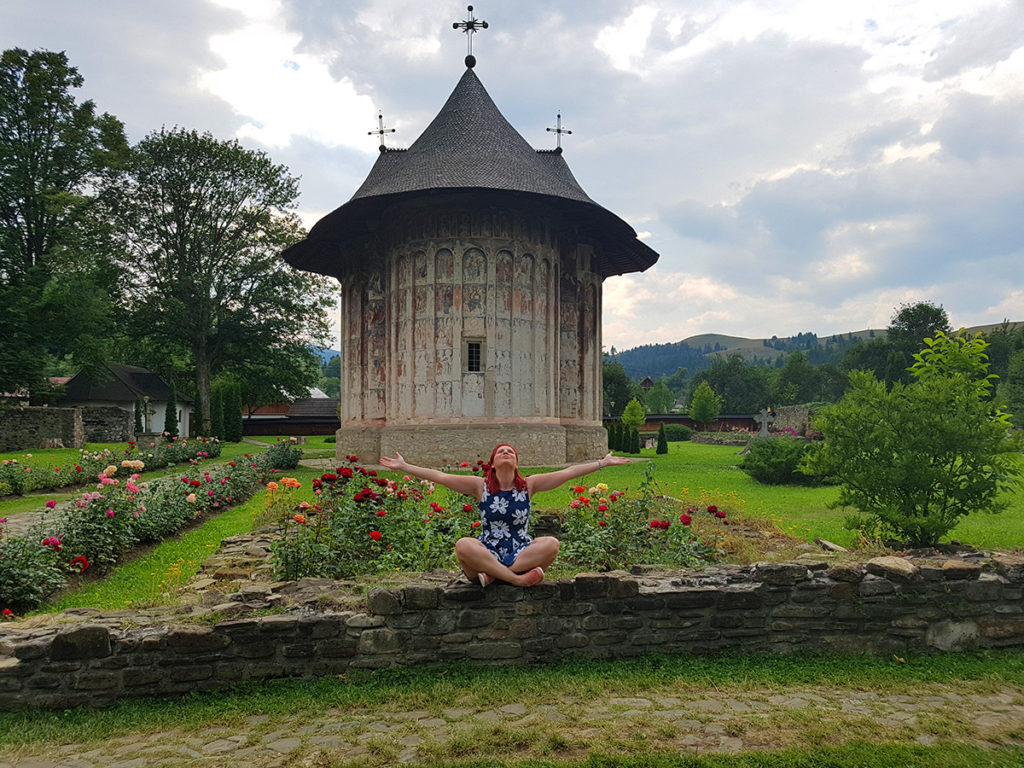- Tourist Information
- Map
- Why is the Humor Monastery famous?
- A religious gem in an enchanting setting
- The frescoes of the Monastery
- UNESCO heritage
- Who is buried at Humor Monastery?
- Defense tower
- What legends does the Humor Monastery hide?
- The legend of Master Toma Zugravul
- The Legend of Jesse’s Tree
- Legend of the Brides
- The Legend of the Black Stone
Tourist Information
| Construction Year | 1530 |
| Type | Monastery / UNESCO |
| Style | Moldavian |
| Founder | Teodor Bubuiog |
| Getting there | Car, bus (from Gura Humorului), 3 ½-mile walk from Gura Humorului Nearest train stations: Gura Humorului The closest airports are located in Suceava (SCV) – www.aeroportsuceava.ro Iasi (IAS) – www.aeroport.ro |
| When to visit | Monday – Sunday, 9 am – 6:30 pm Admission fee: 5 lei ($1.5) Camera/ Photo fee: 10 Lei ($2.5) |
| Top tourist attractions near this location | Folk Traditions Museum of Bucovina (5 Km) Voronet Monastery (10 Km) Schitul Daniel Sihastrul (3 Km) |
| Location | Manastirea Humorului, Suceava, Romania, Europe |
Map
Why is the Humor Monastery famous?
A religious gem in an enchanting setting
Between the picturesque peaks of the hills and the shadows of the great mountains, next to the gentle course of the Humor River, the Humor Monastery is pampered, a gem in a setting of perfect beauty.
The frescoes of the Monastery
The frescoes that cover the walls of this sanctuary were given by the brush of the talented Toma Zugravul in 1535, showing the warmth of the red brick tones in an inviting visual dance.
Rhythmed by the sounds of the times, the frescoes of Humor warm with the story of the Akathist of the Annunciation on the southern facade, while the Tree of Jesse spreads its branches on the northern facade. The Last Judgment depicted on the Western facade opens doors to a transcendent reality, while the Last Supper embodies the procession of saints, apostles, and angels, crowning the side apses and altar with divine radiance.
UNESCO heritage
The Humor Monastery attested with nobility by being included in the UNESCO World Heritage list, weaves together tradition and history in vivid colors under painted arches.
In harmony with the time, Humor was one of the first workshops of colors on canvas in Bucovina, and together with Voronet, it remains a treasure rooted in the past, shining with the artist’s effort and spiritual dedication.
Who is buried at Humor Monastery?
Under the stone-engraved portrait of Teodor Bubuiog and his wife, the tombstone guards their passage to eternity. In the holy silence of the place, Petru Rareș and his wife find shelter as well, eternity placed in the walls of the church.
Defense tower
In 1641, a defense tower was carefully erected, reminiscent of the fortified churches of Transylvania, with thick stone walls that preserve the story of the times in all its grandeur.
What legends does the Humor Monastery hide?
Although not as well-known or well-documented as other historical or sacred sites, the Humor Monastery has also inspired several legends and stories over time. Here are some of these legends and myths associated with the Humor Monastery:
The legend of Master Toma Zugravul
One of the legends refers to Toma Zugravul, the artist who painted the famous frescoes of the monastery. It is said that Thomas the Painter was assisted in his creations by angels and that every night he left his brush to paint alone, under divine guidance. This explains the perfection of detail and the astonishing quality of the frescoes.
The Legend of Jesse’s Tree
The exterior frescoes of the monastery show a tree that is said to be related to a biblical legend. According to this legend, Saint Joseph, the father of Jesus, would have fallen asleep under a tree while guarding the flocks. This tree became the Jesse Tree, and the Humor Monastery would have been built on the site where this event took place.
Legend of the Brides
It is said that every Thursday, brides getting married in the neighboring village stopped at the monastery to ask for a blessing. The blessing of the monastery was believed to bring luck and happiness to the marriage. This gave rise to the legend that brides wishing for a happy marriage should pass by the monastery on their wedding day.
The Legend of the Black Stone
In the courtyard of the monastery, there is a black stone that is said to have healing powers. According to legend, this stone would have been brought from Jerusalem and would have the ability to cure diseases and bring good luck to those who touch or kiss it.
















